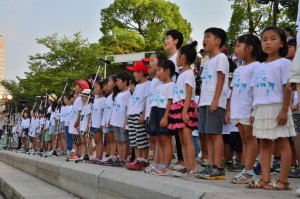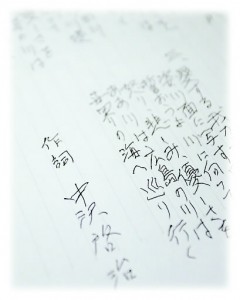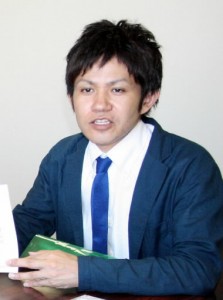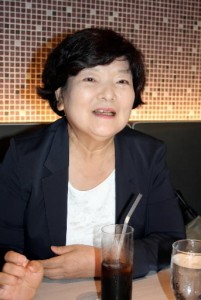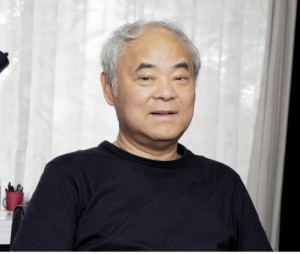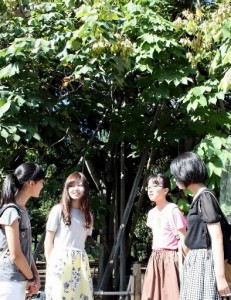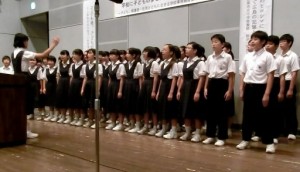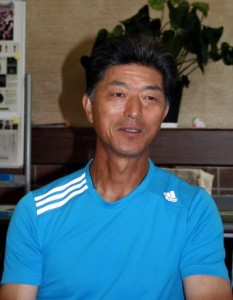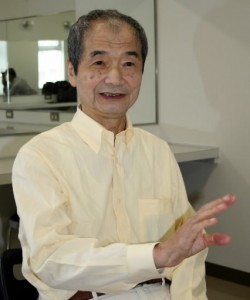Peace Seeds: Teens in Hiroshima Sow Seeds of Peace (Part 17)
Sep. 10, 2015
Part 17: Songs for peace promote harmony in the worldiv
There are various ways to appeal for the importance of peace. One such way is through song. A song can embody the wish for a world without war and discrimination through its melody and lyrics, and convey that wish to many people. And when the song is sung in chorus, its power to make this appeal grows even stronger because the wishes for peace of many are then combined.
Among the songs that wish for a peaceful world and hold a special connection to Hiroshima, the junior writers chose a handful for this article. We then interviewed those who were involved in writing the songs, and singing the songs in chorus, and asked about the essential messages expressed through this music.
The song called “Hiroshima Ai No Kawa” (“Hiroshima’s Rivers of Love”), created two years ago, is based on a poem written by the late Keiji Nakazawa. Mr. Nakazawa was the manga artist behind Barefoot Gen, a comic book series which depicts the experiences of a boy living in Hiroshima at the time of the atomic bombing. This year, which marks the 70th anniversary of the bombing, the song has been sung in many settings, such as along the river by the A-bomb Dome. This song, and many others, emphasize such things as “kindness,” “smiles,” and “love and peace.” We believe that voices in song can heal society, and regularly singing songs of peace will gradually help create a more peaceful world.
“Hiroshima Ai no Kawa” (“Hiroshima’s Rivers of Love”): A melody of hope
On the evening of August 6, voices singing “Hiroshima Ai no Kawa” soared above the bank of the Motoyasu River, opposite the A-bomb Dome. The lyrics to the song were written [in Japanese] by the late Keiji Nakazawa, the author of Barefoot Gen.
“Let us pledge our anger, sorrow, and kindness to the river...”
About 170 people sang in unison, a chorus of cicadas humming in the background. The singers included children clad in identical T-shirts and Tokiko Kato, a professional vocalist. Their voices rose gracefully above the river.
“I sang with the wish for a peaceful world. The audience listened to us closely,” said Nanami Tsuchimoto, 16, a first-year high school student from Asaminami Ward, who took part.
“Hiroshima Ai no Kawa” was sung in a variety of places this summer. At the Hiroshima Peace Concert, held at JMS Aster Plaza in Naka Ward on July 31, the entire audience joined in to sing the song. Ayuna Takamori, 16, a second-year high school student and a member of the Hiroshima Junior Chorus, expressed enthusiasm for the song, saying, “It’s a song that can overcome the language barrier to touch people’s hearts. I will continue to sing this song and convey Mr. Nakazawa’s wish for a peaceful world.”
Before we began investigating this song, we didn’t know it very well. But we naturally started singing along while listening to the live performances at the hall and by the river. The song is filled with strength, hope for the future, and kindness, flowing on a peaceful melody. As a new song from Hiroshima, we hope it helps communicate our wish for a peaceful planet to people around the world. (Kohei Furohashi, 16 and Atsuhito Ito, 12)
Composer sympathized with the poem’s message
Katsuhiko Yamamoto, 36, is a resident of Tokyo and the composer who created the music for “Hiroshima Ai no Kawa.” He encountered Mr. Nakazawa’s poem in 2013 and felt it held a gentle message, in contrast to the anger expressed in Barefoot Gen. Mr. Yamamoto sympathized with the message of the poem, which Mr. Nakazawa had conveyed over the years through his work: the wish for the happiness of his children’s and grandchildren’s generations. Imagining a song that children could sing together in their classrooms, he crafted music for “a song that will be handed down to people in 100 years.”
When Mr. Yamamoto spoke to Misayo Nakazawa, 72, Mr. Nakazawa’s widow and a resident of Naka Ward, and offered to turn her husband’s poem into a song, she encouraged him. She said, “He used to say he wanted a young person to put his poem to music. I think he said this because he thought it would make the song more appealing to the younger generation.”
Ms. Nakazawa said, “So many people died in the rivers of Hiroshima a result of the atomic bombing. We must never forget that. Despite his anger and sorrow, I think my husband had children in mind when he wrote the poem and intentionally chose softer expressions.” She added, “It’s important that you share the message of the song by singing it together with others. Taking this song as an opportunity, I hope young people will think more, and learn more, about a peaceful world.” (Hinako Saiki, 16 and Miki Meguro, 12)
“Aogiri no Uta” (“Song of the Chinese Parasol Tree”): Cherish the city of Hiroshima
The song “Aogiri no Uta” is about a Chinese parasol tree that was exposed to the atomic bomb and now stands in the Peace Memorial Park in Naka Ward. The song won the grand prize in the “Songs of Hiroshima” competition that the City of Hiroshima held in 2001. Nanase Morimitsu, 23, a senior at Shimane University, was a third grader at Senda Elementary School when she wrote the music and lyrics for the winning song. When we were in elementary school, we often sang this song, and it is still being sung by children today.
“Don’t forget what happened many years ago. With the song of the Chinese parasol tree, cherish the city of Hiroshima as it moves into the future.”
The song conveys the candid thoughts of the tree, which endured the atomic bombing, and communicates to all the clear wish of peace in the world. Ms. Morimitsu said that her favorite part of the song is: “We have only one wish from Hiroshima, the shining smiles of everyone all over the world.” She hopes that, through her song, as many people as possible will be inspired to think about peace.
It is our hope, too, that this song will become widely known not only in Japan but in other countries as well. We believe that if we could all sing it together, we would get closer to the peaceful world wished for in the song. (Miyu Okada, 14, Ai Mizoue, 13, and Miki Meguro, 12)
“Negai” (“Our Wish”): Peace song now has more than 2,100 verses
This song is also called the 21st-century Hiroshima version of “Imagine,” the well-known song written by John Lennon. The lyrics were first made by gathering input from students at Ozu Junior High School in Minami Ward. Ryuji Takada, 63, the director of the Hiroshima Chorus, then composed the music. It was completed as a choral piece in 2002.
“If from above our heads, missiles and bombs were not being dropped, but rather books and notebooks, we could stop fighting...”
Initially, only four verses were written. But after the project became more widely known among teachers and education officials, additional lyrics for the song were sought via a website. People from inside and outside Japan submitted new lyrics, resulting in more than 2,100 current verses.
According to Motoharu Yokoyama, 56, now a teacher at Ushita Junior High School in Higashi Ward, came up with the idea in 2001, after the September 11 terrorist attacks in the United States. He suggested to his students that they send a wish for peace from Hiroshima, and the project to create the song was then launched.
The song is still sung at schools and at peace-related events. At Ozu Junior High School, where the song originated, students sing it on such occasions as the day in August to reflect on peace. Seri Motoki, 14, the vice president of the student council, said, “We will treasure the song, which is filled with the wish for peace, and pass it on to younger students.”
Mr. Yokoyama shared his hopes by saying, “I’d like this song to serve as a way for students to gain a global perspective and learn more about the world. I also hope they will fulfill the wishes people have expressed in the song’s many verses.” (Ishin Nakahara, 17 and Miki Meguro, 12)
“Daichi Sansho” (“Ode to the Land”): Cultivate our sensitivity
This song is considered a standard for singing about peace in a chorus. It is the seventh and final part of the cantata “Tsuchi no Uta” (“Song of the Earth”), which was created in 1962. The song expresses appreciation for the land, which was able to heal despite the catastrophe caused by the atomic bombing: “Celebrate and praise mother earth...” The song is also sung by students visiting Hiroshima on school trips.
The lyrics were written by the late Atsuo Oki, who grew up in Hiroshima, with music by Shin Sato, 77, a resident of Tokyo.
The song is about a grand theme, but we think it has become widely embraced. When we asked Mr. Sato about this, he said, “When I composed the music, I felt that simplicity was important so that many people can try and sing it.”
Mr. Sato advised, “To realize a peaceful world, it’s vital for each of us to think about this issue seriously. In this light, we must cultivate our sensitivity. I’d like people to use this song to do that.” I want to spend more time with such songs to enhance my own sensitivity. (Nanaho Yamamoto, 15)
Junior writers’ impressions
After interviewing Mr. Yokoyama, who produced the song “Negai,” I was able to learn a variety of new things. For example, that this is a song in which the number of verses continues to grow, and that it’s sung on many occasions. As I hadn’t had much chance to encounter songs about peace, I’m grateful that I could learn more about them. I want to keep singing this song and pass it on to younger people, while thinking about the message put into it by Mr. Yokoyama and his students. (Ishin Nakahara)
It was a valuable experience for me to meet Misayo Nakazawa, the wife of the late Keiji Nakazawa, and interview her. Unlike the harsh scenes of Barefoot Gen, his lyrics in “Hiroshima Ai no Kawa” are very soft and gentle. Through the song, everyone, even small children, would naturally think about caring for the members of their family and the other people around them. I thought it’s great that this song was made. (Hinako Saeki)
Until now, I hardly thought about the relationship between peace and songs. But through our work writing this article, I came to feel that songs actually have the power to move people. Even when I didn’t know the song, I began to be moved by the song’s rhythm, as were the others around me. I realized that music is one way of conveying the wish for a peaceful world to many people. (Kohei Furohashi)
I talked with Shin Sato, the composer who created the music for the song “Daichi Sansho,” which is the final part of the cantata “Tsuchi no Uta.” During the interview, I was able to draw out a unique comment from his perspective as a composer: “It’s vital to cultivate your sensitivity.” I think singing is an effective way to nurture this sensitivity. Through my experience working on this article, it struck me that songs can have a powerful impact on people. (Nanaho Yamamoto)
By working on this article, I came to see how people’s wish for a peaceful world can be expressed through songs. Nanase Morimitsu, who wrote the song “Aogiri no Uta,” said that some people cried while listening to her song. I think her honest wish for peace is imbued in the song, and this can touch the hearts of many people. Because there are many more songs about peace, I’d like to learn more about them. (Miyu Okada)
I really felt the power of songs in this assignment. I interviwed Nanase Morimitsu, who wrote the song “Aogiri no Uta.” She wrote this song when she was in third grade in elementary school. Later, when I was an elementary school student myself, I could feel her wish for a peaceful world that she put into the song. Regardless of age, songs can touch everyone. I was very surprised by this and I thought that I’d like to keep singing these songs. (Ai Mizoue)
Misayo Nakazawa told us that the song is a seed for thinking about a peaceful world. Because everyone can sing, the wish for a peaceful world that the song expresses can be communicated more widely. Our assignment this time made me feel that if more and more people would sing songs of peace and think about their message, we could move closer to a peaceful world. (Miki Meguro)
I listened to a lot of songs while working on this article, and thought that music is one way to appeal for peace in the world. Even if the song is in a different language, we can sing it because melody is something shared by everyone in the world and singing songs can make us smile. I actually felt this at the performance by the Motoyasu River. So I want to sing more songs and smile more, too. (Atsuhito Ito)
What is Peace Seeds?
Peace Seeds are the seeds of smiles which can be spread around the world by thinking about peace and the preciousness of life from various viewpoints. To fill this world with flowering smiles, 49 junior writers, from the sixth grade of elementary school to the last year of high school, choose themes, gather information, and write articles.
(Originally published on September 10, 2015)

